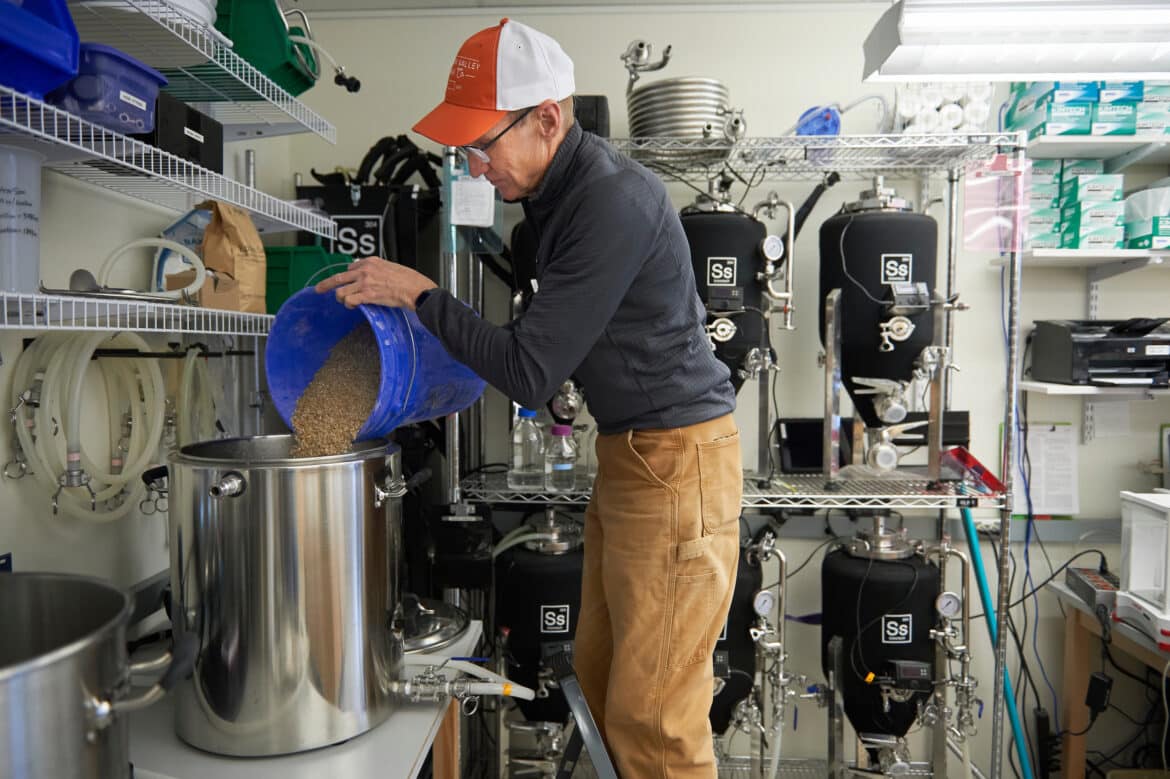BOZEMAN – Thanks to a new license, barley research at Montana State University is set to extend beyond breeding and malting to the science behind brewing.
In November, the Montana Board of Regents cleared MSU to apply for an academic brewer license. Similar to the licensure used by commercial breweries, the license allows researchers in MSU’s Barley, Malt and Brewing Quality Lab to brew small amounts of beer as part of their research, identifying beneficial traits in new barley lines and evaluating how different varieties perform at each stage of the pipeline from field to brewery. MSU’s application for the license was approved on Feb. 28.
“Brewing is a complicated process that involves not only barley, but also the barley-growing environment, yeast and many other factors,” said Jamie Sherman, head of MSU’s barley breeding program and an associate professor in the Department of Plant Sciences and Plant Pathology in the College of Agriculture. “If we don’t understand this process, how can we possibly breed for it?”
For the past three years, more barley has been planted in Montana than in any other state, according to data collected by the U.S. Department of Agriculture’s National Agricultural Statistics Service. In 2023, 1.2 million acres of barley were planted in Montana. Barley has a variety of uses, and special lines can be bred for feed, forage and malting.
However, Sherman said, releasing a new variety before knowing how it performs in malting and brewing means accepting a lot of uncertainty. Just because a new line performs well in the field doesn’t mean it will malt or brew well.
“This new ability will allow us to make sure a release doesn’t have something bad about it once it’s brewed, and it also may help us identify some positive traits in new lines that could help them perform well for brewers,” said Sherman. “Ultimately, our lines are only going to have success if a grower is willing to grow it and the end user is willing to use it. There’s been a disconnect there, and this will help close that.”
Sherman established MSU’s malt quality lab in 2016. Before the lab was created, she sent barley and malt samples to a U.S. Department of Agriculture lab in Wisconsin to get some of the data she needed for breeding, which slowed down the process and limited the number of samples she could test. By conducting malt and now brewing quality research in-house, the team can collect any data needed for in-lab research or requested by Montana barley producers.
The academic brewer license came into being through House Bill 31, sponsored by Rep. Ross Fitzgerald, R-Power, during the 2023 Montana Legislature. After the bill became law, MSU’s request to apply for an academic brewer license was approved by the Montana Board of Regents last fall. New research endeavors will be spearheaded by Sherman and Bruce McMahon, MSU’s first-ever research brewer. With more than a decade of experience in the brewing industry working with Anheuser-Busch, McMahon said the opportunity to conduct brewing-quality research at MSU was a perfect fit.
“We’ve never had a brewer. It’s like this incredible gift,” said Sherman. “He’s got industry experience and he knows how to talk about brewing and to brewers. Just like we’ve started doing malting research in recent years, he can start doing brewing research. I’m sure that a year from now, we’ll be working on something we never even thought about.”
Using a small suite of in-lab brewing equipment, Sherman and her team will evaluate new and existing barley varieties for end-use quality. Because the brewing process involves so many factors, the possibilities are endless, she said.
“Brewing involves living organisms interacting, and so a lot of it is the yeast, which has a huge impact on the flavor and the product,” said Sherman. “It has a lot to do with the minerals that happen to be in the soil that get incorporated into the barley, and then the minerals in the water that you use to brew with. We know that all of those factors are impacting the malt, but how does that carry over into the flavor? We don’t have that data yet, and that’s our next step now that we’re able to brew.”
In addition to in-house barley and brewing research, the lab will extend its services to brewers or maltsters who want quality and chemical analyses done on their products. Producers will be able to send samples to Sherman’s team for analysis on everything from alcohol content and bitterness to gluten levels.
For Sherman, conducting brewing research is the natural continuation of her lab’s evolution. Now, she says, MSU will be able to provide knowledge and data on every stage of the barley breeding, growing, malting and brewing processes, better serving the region’s producers and the consumers of Montana’s barley acreage.
“When you’re a breeder, one of the most important things is gathering a lot of data over a number of years from barley grown in different environments, which will make your selections a lot better,” Sherman said. “Now, we can get our own brewing data, which helps us to make better decisions when developing varieties. It’s already empowered us.”
###
MSU News Service


